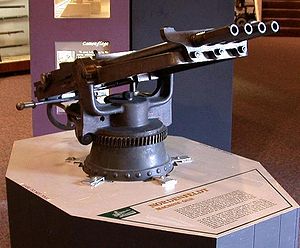Difference between revisions of "1-inch Nordenfelt gun"
(moved Commons category link to standard location in External links section; added link to List of naval guns) |
m (Reverted edits by Kylerhoover (talk) to last revision by Jontas) |
||
| (3 intermediate revisions by 2 users not shown) | |||
| Line 18: | Line 18: | ||
|wars= | |wars= | ||
<!-- Production history --> | <!-- Production history --> | ||
| − | |designer= | + | |designer=Helge Palmcrantz |
|design_date= | |design_date= | ||
|manufacturer=Nordenfelt Guns and Ammunition Company | |manufacturer=Nordenfelt Guns and Ammunition Company | ||
| Line 53: | Line 53: | ||
==Description== | ==Description== | ||
| − | The gun was an enlarged version of the successful rifle-calibre Nordenfelt hand-cranked "machine gun" designed by | + | The gun was an enlarged version of the successful rifle-calibre Nordenfelt hand-cranked "machine gun" designed by Helge Palmcrantz and was intended to combine its rapid rate of fire with a projectile capable of deterring attacking torpedo boats. The gun fired a solid steel bullet with hardened tip and brass jacket : under the terms of the St. Petersburg Declaration of 1868, exploding shells weighing less than 400 grams were not allowed to be used in warfare between the signatory nations. |
[[File:1-InchNordenfelt4BarrelGunNavalActionDrawing.jpg|thumb|left|<center>Woodcut depicting [[Royal Navy]] gunners in action with four-barrel model. The gun captain, left, is operating the training handwheel</center>]] | [[File:1-InchNordenfelt4BarrelGunNavalActionDrawing.jpg|thumb|left|<center>Woodcut depicting [[Royal Navy]] gunners in action with four-barrel model. The gun captain, left, is operating the training handwheel</center>]] | ||
| Line 78: | Line 78: | ||
==External links== | ==External links== | ||
| − | |||
*[http://www.cerberus.com.au/fclick/fclick.php?id=139 Description, Drill, Ammunition. Manual for Victorian Naval Forces 1887, pages 41 - 52] from HMVS Cerberus website | *[http://www.cerberus.com.au/fclick/fclick.php?id=139 Description, Drill, Ammunition. Manual for Victorian Naval Forces 1887, pages 41 - 52] from HMVS Cerberus website | ||
*[http://www.victorianshipmodels.com/antitorpedoboatguns/Nordenfelt/nordenfelt1inch4.html 1 inch 4-barrel Nordenfelt Mk III Machine-Gun] History, technical details, animations | *[http://www.victorianshipmodels.com/antitorpedoboatguns/Nordenfelt/nordenfelt1inch4.html 1 inch 4-barrel Nordenfelt Mk III Machine-Gun] History, technical details, animations | ||
| Line 86: | Line 85: | ||
[[Category:Naval guns of the United Kingdom]] | [[Category:Naval guns of the United Kingdom]] | ||
| − | |||
[[Category:25 mm artillery]] | [[Category:25 mm artillery]] | ||
Latest revision as of 21:21, 3 October 2011
| 1 inch Nordenfelt gun | |
|---|---|
 Four-barrel version | |
| Type | Naval gun |
| Place of origin | |
| Service history | |
| In service | 1880 - 1890s |
| Used by | Many navies |
| Production history | |
| Designer | Helge Palmcrantz |
| Manufacturer | Nordenfelt Guns and Ammunition Company |
| Specifications | |
| Weight | 447 pounds (203 kg)[1] |
| Barrel length | 35.48 inches (901 mm)[1] |
| | |
| Shell | 7.25 ounces (0.206 kg) solid steel bullet with brass jacket[1] |
| Calibre | 1-inch (25.40 mm) |
| Muzzle velocity | 1,464 feet per second (446 m/s)[1] |
The 1 inch Nordenfelt was an early rapid-firing light gun intended to defend larger warships against the new small fast-moving torpedo boats in the late 1870s - early 1880s.
Description
The gun was an enlarged version of the successful rifle-calibre Nordenfelt hand-cranked "machine gun" designed by Helge Palmcrantz and was intended to combine its rapid rate of fire with a projectile capable of deterring attacking torpedo boats. The gun fired a solid steel bullet with hardened tip and brass jacket : under the terms of the St. Petersburg Declaration of 1868, exploding shells weighing less than 400 grams were not allowed to be used in warfare between the signatory nations.

The gun was used in one, two and four-barrel versions. The ammunition was fed by gravity from a hopper above the breech subdivided into separate columns for each barrel. The gunner loaded and fired the multiple barrels by moving a lever on the right side of the gun forward and backwards. Pulling the lever backwards extracted the fired cartridges, pushing it forward then loaded fresh cartridges into all the barrels, and the final part of the forward motion fired all the barrels, one at a time in quick succession. Hence the gun functioned as a type of volley gun, firing bullets in bursts, compared to the contemporary Gatling gun and the true machine guns which succeeded it such as the Maxim gun, which fired at a steady continuous rate.
The gunner was occupied with manually operating the loading and firing lever, while the gun captain aimed the gun and operated the elevation and training handwheels.
It was superseded for anti-torpedo boat defence in the mid-1880s by the new generation of Hotchkiss and Nordenfelt "QF" guns of 47-mm and 57-mm calibre firing exploding "common pointed" shells weighing 3 - 6 pounds.
Ammunition
British Mk VI round (left) and blank round (right)
See also
Notes
Cite error: Invalid <references> tag;
parameter "group" is allowed only.
<references />, or <references group="..." />References
External links
- Description, Drill, Ammunition. Manual for Victorian Naval Forces 1887, pages 41 - 52 from HMVS Cerberus website
- 1 inch 4-barrel Nordenfelt Mk III Machine-Gun History, technical details, animations
- 1 inch 2-barrel Nordenfelt Machine-Gun History, technical details, animations
